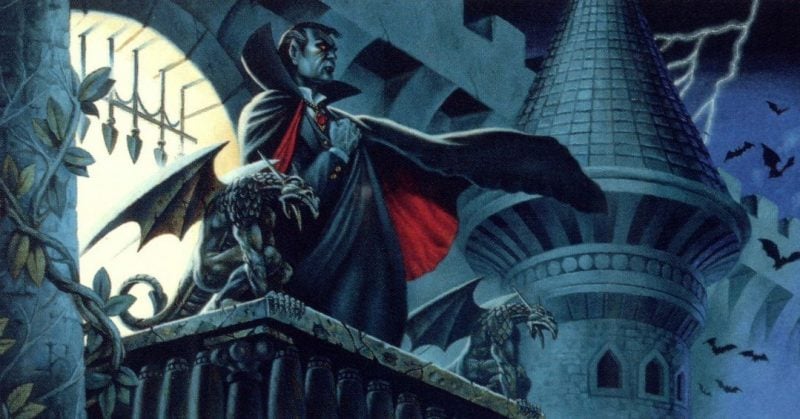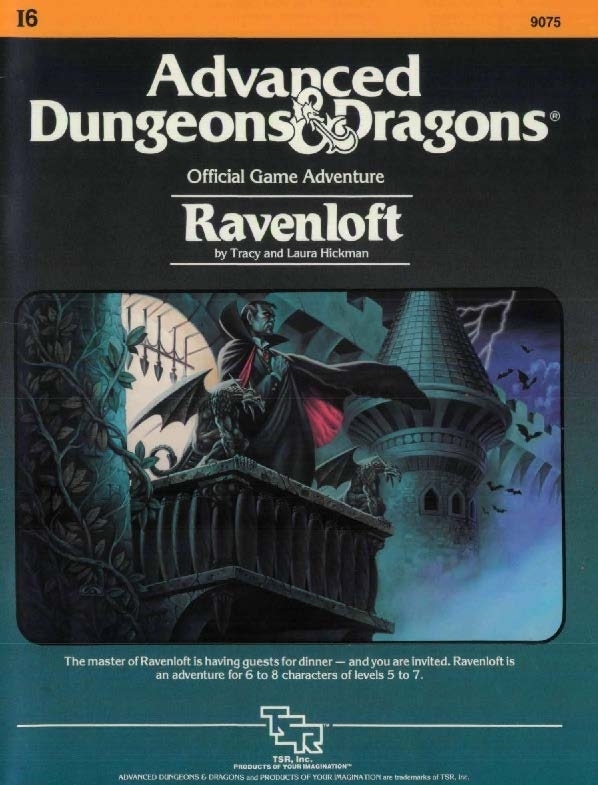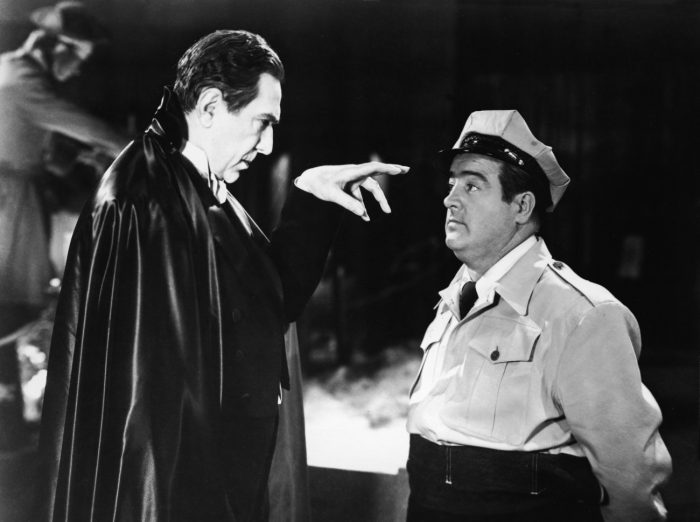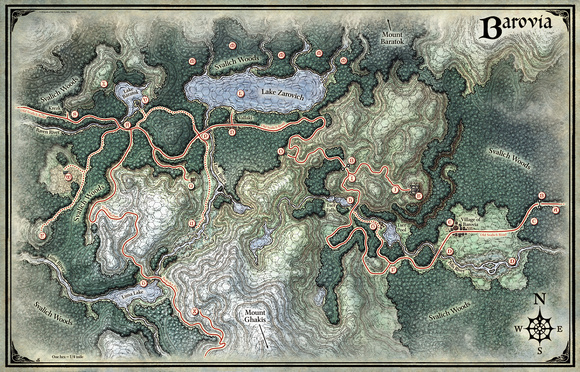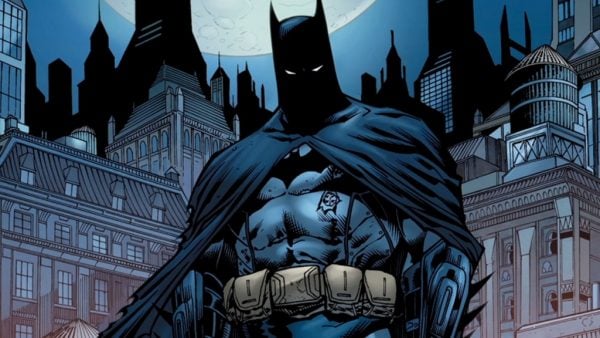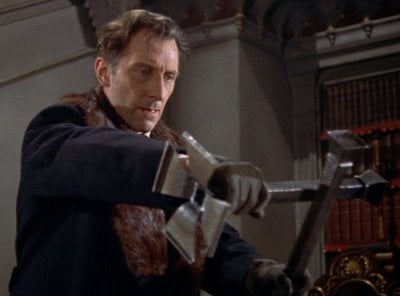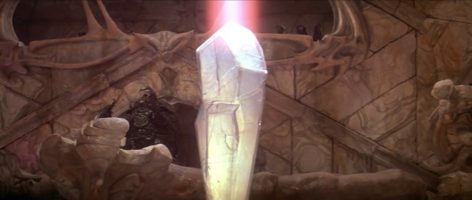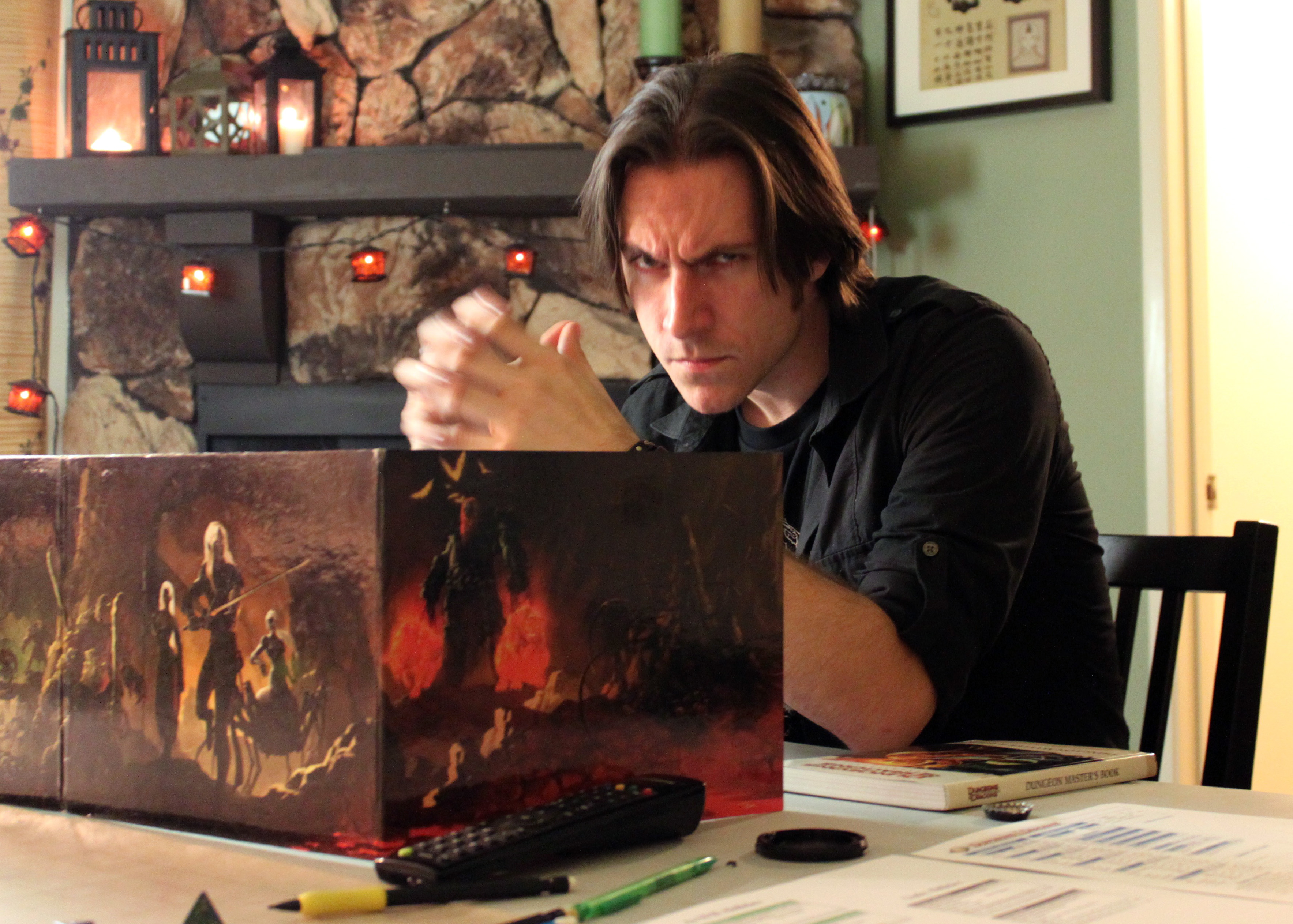D&D Realm Guide: Ravenloft

Step through the mists and into a land of darkness and terror. Where an ancient count rules and every shadow hides something sinister. Welcome to Ravenloft.
Make sure your wooden stake is sharp, that your vial of holy water is secure, and get your cleric to cast protection from evil, because it’s time to visit the land where nobody drinks…wine. It’s time to visit Ravenloft *thunderclap.* Originally appearing in the titular module I6: Ravenloft, the setting is known for its darker take on D&D. With its shades of Gothic horror and monstrous villains, it’s easy to see why it had universal appeal.
Not pictured: Ravenloft’s most famous tourists–Abbot and Costello.
Ravenloft is unique among the various campaign settings in that, unlike Faerun or Krynn, or even Athas, Ravenloft doesn’t occupy a planet, or even a continent–instead, Ravenloft is a Twilight Zone-esque demiplane (of dread!) that characters can walk into from anywhere in the world.* And much like the Twilight Zone, Ravenloft can be wildly different from encounter to encounter. Characters that step through the mists might find themselves wandering through a sleepy town with horrors lurking beneath, or they might be facing the deadly curse of an ancient mummy. Names like Vecna and Soth are whispered here, and have left their mark on the world.
But none have made as much of an impact as the villain of Ravenloft, Count Strahd von Zarovich. So in order to figure out what makes this ever-shifting land of mists and darkness tick, let’s dive into the first appearance of Count von Zarovich: I6: Ravenloft.
I bid you welcome.
Right away, it’s clear that this adventure is no ordinary D&D module. Before even getting to the adventure, the DM is greeted with the following:
I am the ancient. My beginnings are lost in the darkness of the past. I am not dead. Nor am I alive. I am undead, forever.
Advertisement
The next few pages detail the setup of the adventure–most notably though, they point out that the entire adventure centers around Strahd. When Strahd is dead, the adventure is over (though that will take some work), so DMs are advised to have him retreat and try to isolate weaker party members. There are no less than four warnings about playing Strahd as intelligently as you would a normal PC in as many pages at the game’s outset.
The DM is also instructed to use playing cards to randomly determine the vampire’s motivations, goals, and the locations of the important treasures of the module–complete with cryptic hints to hand out to the PCs when they have their fortunes told by an old gypsy woman. The rest of the module reinforces the idea that Strahd is his own monster, and that the adventurers aren’t in Kansas anymore. In addition to the gypsy fortune teller, players can encounter a dark forest full of werewolves, a burgomaster trying to protect his daughter, and of course the grand castle up on the craggy hill, Castle Ravenloft.
There are a lot of little touches that really capture the gothic horror elements of the module (and the setting). There’s a thick fog that lurks at the edges of the land of Barovia, the NPCs all have their own reasons for fearing Strahd. And there’s a pall of tragedy hanging over the whole affair. Even should players find the legendary sun sword of the module, they might be reluctant to strike down the villain.
There’s even an optional epilogue that captures the feeling of being able to breathe at last–once the players have defeated Strahd, the mists disappear and light returns to the world. Like the end of a long night.
And there’s something in that last idea that makes Ravenloft stand out from other settings as well. Even if you play an extended campaign like the Curse of Strahd, your encounter with Ravenloft is never meant to be permanent. Ravenloft isn’t a place, so much as it is an idea: a moment of dread that lingers a moment longer than it should. That threatens to consume you. Though they may claim your soul, adventures in Ravenloft are meant to end.
I think it’s because Ravenloft leans so heavily on its source material. Stories in the gothic horror tradition aren’t about finding and killing a monster–they’re often about taking a look at why the monster is the way he is (and perhaps culminating in a number of, “we’re not so different you and I” speeches), or looking at the corrupting effects of what the monster represents. With Strahd, for instance, the theme of wanting to force someone to love you plays heavily.
There’s a villain like that in each different “pocket” of Ravenloft–remember, Ravenloft is not a continent or world, but the Demiplane of Dread, bordered by the ineffable Mists of Ravenloft which contain dark and sinister powers within–powers that seek out particularly selfish and evil individuals and imprison and torment them by making them masters of their own realm of terror. Also called the islands of terror, these realms all are ruled over by a powerful villain called a darklord. Strahd, for instance, is the darklord of Barovia.
Other darklords include the lich Azalin, Lord Soth–the iconic death knight, and presumably Vecna was once a darklord of Ravenloft before escaping. Presumably getting drawn into the Mists was all a part of Vecna’s plan anyway. But each of these figures casts a shadow over their respective domain–realms within Ravenloft are unique in that they exist as fuel for adventure. They are full of people who toil under the often oppressive regime of the darklord and who require the player’s aid.
That’s because players represent the other side of horror stories–if the villains are meant to be held up as monsters, the PCs, by contrast are given a chance to learn the lessons the darklords cannot. Or will not. They’re often counted on to be agents of change–in 3rd edition, Ravenloft was referred to as the Crucible of Virtue for this reason. The idea was that the players were being tested any time they were drawn in by the Mists.
Each realm of Ravenloft could be an article unto itself, though. Because in spite of the realms being designed as only vaguely defined areas that all are bordered by mists, the realms are all surprisingly detailed–oftentimes the adventures that take place in them will span multiple locations, sometimes even crossing planar boundaries. The House on Gryphon Hill, for instance, is a Jekyll and Hyde-esque adventure (featuring good Strahd and evil Strahd) that culminates with an entire town falling into the Mists.
These realms often have their own entire history (fleshed out in both adventure modules and novels in many cases), that get rewritten throughout the editions. Whole realms have vanished over the course of Ravenloft’s history. When 2nd edition came out, no less than twelve Islands of Terror vanished without a trace, only to return in 3.5. But one thing remains constant–the land of Barovia and its vampire liege. And, since we’ve already outlined what’s at stake in Strahd’s realm, you can count on the fact that we’ll be looking at Barovia (and also Ravenloft’s) history.
As far as anyone can tell, the history of Barovia begins in the year 351. This is the year that Strahd rises to power in Barovia, having driven back a horde of invading barbarians known as Tergs. This is also when Strahd falls in unrequited love with a young woman named Tatyana, who was in turn in love with Strahd’s brother, Sergei. Spurned, and hating and fearing what he represented (Strahd didn’t like the idea of being old, and felt he had wasted his youth) Strahd murdered his brother–depending on the edition made some kind of unholy deal to gain the power needed to accomplish this–and proceeded to become the vampire lord of Ravenloft. In response, Tatyana kills herself, Barovia is shrouded in Mist, and Strahd moves into a castle and broods.
Yeah, kind of like that, but with a different sort of bat/man.
The next hundred-ish years see Strahd disappearing from the public eye, hunting down the occasional traitor and figuring out how best to pine for his lost “love” with his newfound undead powers, but until the Vistani (those gypsies I mentioned earlier) arrive, nothing much happens. The arrival of the Vistani, however, heralds an era of change for Barovia. The woods of Svalich become haunted–and when a young boy is saved there, he begins a religious movement known as the Cult of the Morninglord. Also during this time of arrival, Azalin appears in Barovia. He and Strahd become cautious allies and nothing ever goes wrong between them.
Except for that whole bit in the year 579 where Strahd and Azalin travel to the realm of Mordent and get Jekyll and Hyded until the entire realm falls into Ravenloft. Then Azalin becomes a conquering Lich Lord, but Strahd manages to drive him off and Azalin sets up his own domain in Darkon. All the while, more and more domains are appearing within the Mists, so there’s actual resources to fight over.
This era of “expansion” sees the appearance of a number of realms: Bluetspur, Arak, monstrous Forlorn, even a desert realm known as Har’Akir. This era comes to a head with the Dead Man’s Campaign–an invasion of the realms of Ravenloft by Vlad Drakov a mercenary warlord from Krynn whose campaigns are forever doomed to fail. And fail they do–four times in a row, with each defeat driving the man more and more mad. This time period also sees the rise of Dr. Abraham van Helsing Rudolph von Richten, who dedicates his life to fighting the monstrous horrors of Ravenloft by exposing their weaknesses.
“We will crush von Zarovich with one swift stroke!”
This all culminates in the Grand Conjunction (735-740), which Azalin (ever determined to escape his nightmarish prison) caused through careful manipulations. During the Grand Conjunction, the lands of Ravenloft were struck with tremors, entire realms vanished into the Mists or dissolved into nothingness, and a young Gelfling named Jen brought balance back to the world by returning the shard of a Dark Crystal whence it came.
The next decade sees the fallout of these changes. Scattered domains merge together, Azalin escapes Ravenloft (probably) only to return later to find his kingdom in shambles. Strahd declares another “heir” to Barovia, and everything rolls around to what passes for a present day.
Of course that is just one version of the history of Ravenloft. No doubt it’s being rewritten as we speak–but as I say, it almost doesn’t matter. The reason Ravenloft is so successful as a campaign setting is because it gives its players an opportunity to tell the sort of stories you don’t usually tell in D&D. It’s a break from questing knights and mighty wizards–it’s a dread pallor that falls upon the world for a time. A moment of horror that threatens to swallow everyone up.
So the next time you find yourself in need of a good scare, or to delve into the darkness that lurks in the human soul, you can be sure that the Mists of Ravenloft will find you.
What horrors have you unearthed within the Mists of Ravenloft? Werewolves? Vampires? Vampire Werewolves that are also Frankenstein’s Monsters? Let us know in the comments below!
*Walking out is another matter entirely, best not to worry about it.

